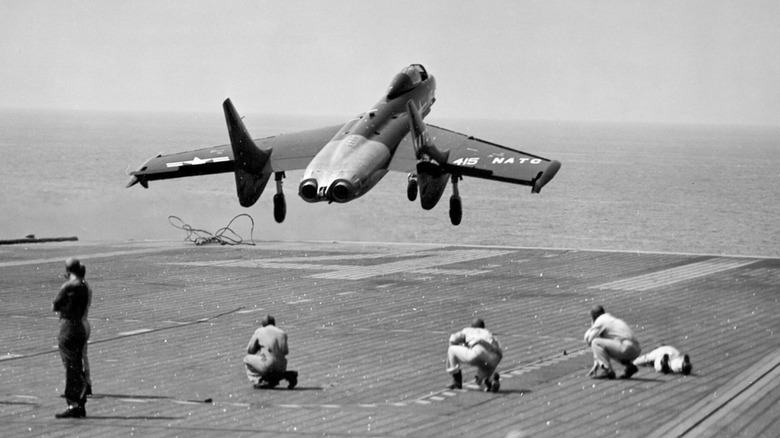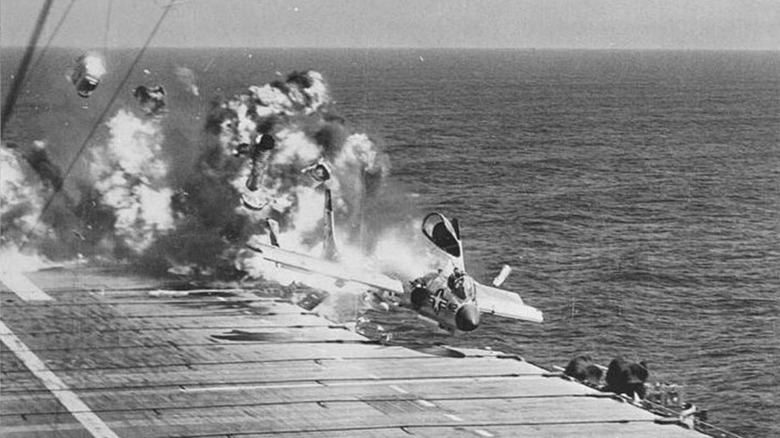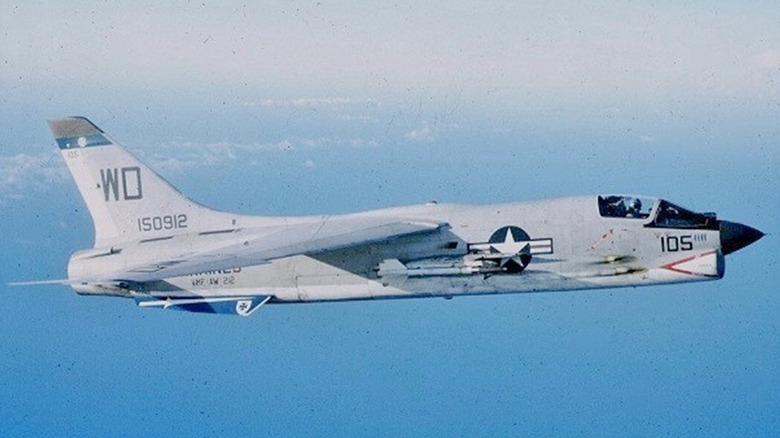This Is The Most Difficult US Navy Jet To Land On An Aircraft Carrier, According To Aviators
For most mere mortals, the act of landing a fighter jet on an aircraft carrier is beyond comprehension. Experienced pilots count it among the most difficult maneuvers to perform. Even if we look at what is considered one of the easiest planes to land on a carrier, the F-18 Hornet, landing a jet on a carrier requires supreme flightmanship. For instance, from when the plane is about 450 feet in the air until landing on the deck, a pilot will make up to 300 minor control adjustments, all in about 18 seconds. Get it wrong and the best-case scenario is a red-faced walk of shame. In the worst case, it could be the last maneuver they perform.
This is in a plane that one pilot described as, "Just a superbly designed aircraft. Solid as a rock coming aboard." The story changes when we look at the other end of the scale and consider the jet that even highly-skilled Navy pilots consider a handful to land. The aircraft in question is the Vought F7U Cutlass, a fighter jet that Navy pilots feared, and one of three Vought jets that were notoriously difficult to land on a carrier. According to former U.S. Navy pilot David Tussey, the plane had unreliable engines and required a high angle of attack during landings. It was a combination that ultimately led him to describe it as "damn near impossible to land on a carrier."
Luckily, it's a blast from the past and not a plane that the current generation of fighter pilots are likely to encounter.
Why was the F7U Cutlass so hard to land on a carrier?
Just because a pilot says a plane is nearly impossible to land on an aircraft carrier doesn't necessarily mean it's a bad plane. After all, it's hard to imagine the legendary SR-71 Blackbird landing on a carrier, but it can hardly be considered a bad plane. Unfortunately, the Cutlass was designed to be a carrier-based plane, so it had no such excuses.
To be fair to the Cutlass (or Gutlass as it was often referred to), it was a pioneering plane that came along early in the jet age. While its flight characteristics were one of the main reasons it was difficult to land, it wasn't the jet's only shortcomings. It also suffered from being underpowered, had troublesome hydraulic flight controls, and lacked forward visibility during landings, thanks to its high nose-up angle.
The accident statistics also support the jet's poor reputation. In a four-year period between 1952 and 1956, there were 78 crashes and incidents involving the Cutlass, of which more than 25% were fatal. It's no wonder that the plane quickly gained another nickname. In dark humor, the pilots referred to the Cutlass as "the Ensign Killer." Ultimately, it was retired from service in 1957, only two years after the last aircraft rolled off the production line. However, it isn't the only Vought jet that gained a reputation with carrier landings; two others are also worthy of mention.
Vought's unlucky trio of carrier jets
The Vought F-8 Crusader was another from the Chance Vought stable that earned a reputation as being "tricky" to land. More specifically, it suffered from similar aerodynamic issues as the Crusader, with the result that the jet was also forced to land with a high-nose-up angle. The angle of attack required when landing was so extreme that engineers had to develop a unique solution to work around the problem.
The answer was something called a "variable-incidence wing". This allowed the pilots to move the wing during the landing and take-off phases for improved flight characteristics and visibility. The wing pivoted around its rear spar, which could adjust the angle by up to seven degrees. Despite its landing difficulties, the plane was well thought of by pilots who considered it a "great fighter aircraft."
Finally, we take a quick look at the third member of the "Chance Vought" triplet of difficult planes to land, the A-7 Corsair. To reduce development costs, the Corsair was loosely based on the Crusader (without the swiveling wings). However, it did carry over some of the more unfortunate landing characteristics of its sibling. The Corsair's engines suffered from a slow response time, and the plane also needed to maintain a high approach speed when landing. The result was a plane that gave pilots little room for error during final approach, with deviations during landing proving incredibly hard to control.


